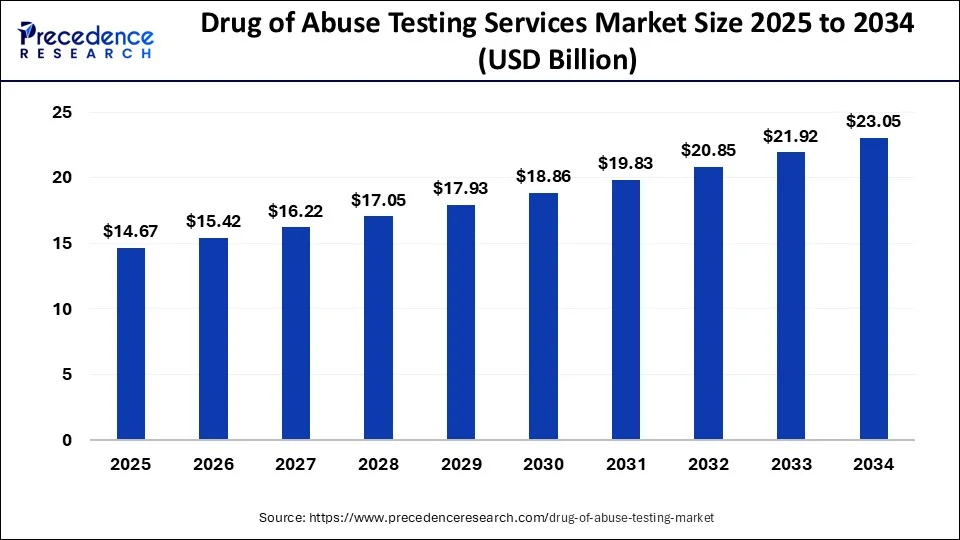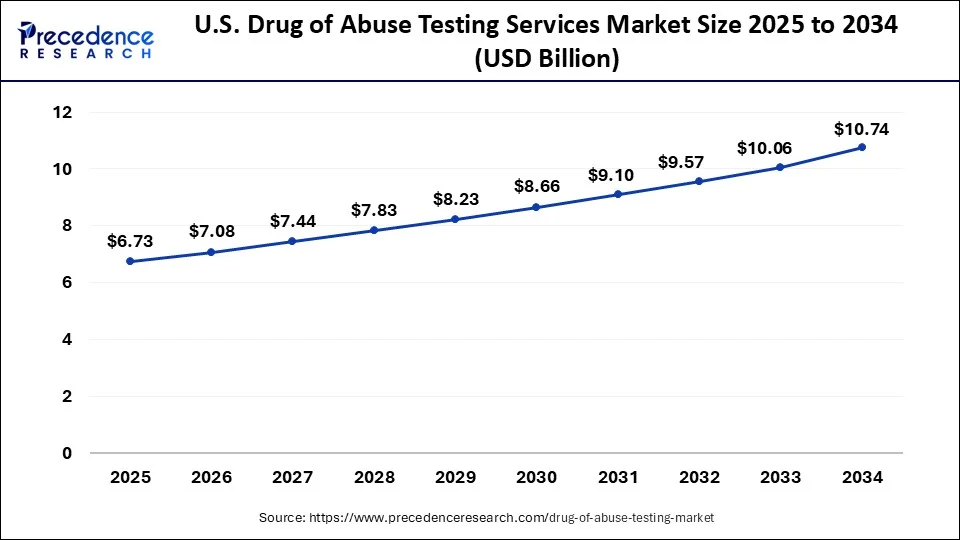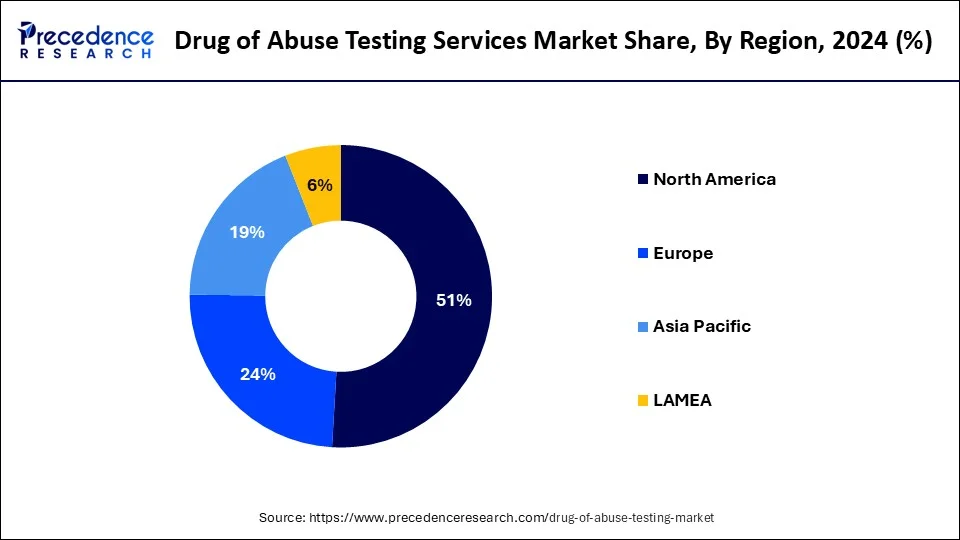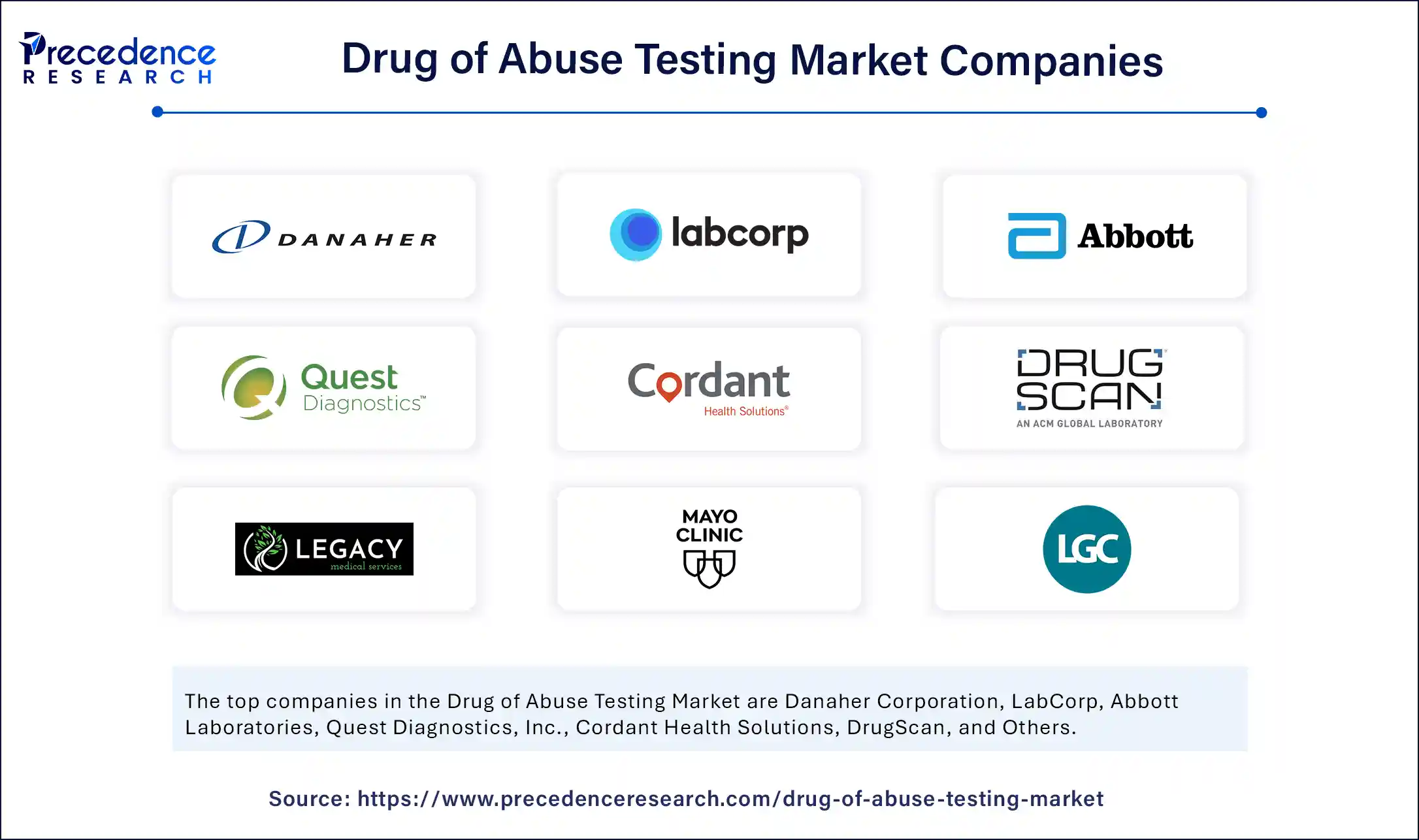List of Contents
Drug of Abuse Testing Market Size and Forecast 2025 to 2034
The global drug of abuse testing market size was estimated at USD 13.95 billion in 2024 and is predicted to increase from USD 14.67 billion in 2025 to approximately USD 23.05 billion by 2034, expanding at a CAGR of 5.15% from 2025 to 2034.

Drug of Abuse Testing Market Key Takeaways
- The global drug of abuse testing market was valued at USD 13.95 billion in 2024.
- It is projected to reach USD 23.05 billion by 2034.
- The market is expected to grow at a CAGR of 5.15% from 2025 to 2034.
- North America dominated the global market with the largest market share of 51% in 2024.
- By product, the rapid testing devices segment captured the biggest market share in 2024.
- By product, the laboratory services segment is expected to grow at a solid CAGR during the forecast period.
- By methodology, the Immunoassays segment generated the major market share in 2024.
- By methodology, the gas chromatography-mass spectrometry segment is expected to expand at a solid CAGR during the forecast period.
- By drug type, the marijuana/cannabis segment contributed the significant market share in 2024.
- By drug type, the opioids segment is expected to grow at a solid CAGR during the forecast period.
- By sample type, the urine segment held the highest market share in 2024.
- By sample type, the saliva segments are expected to grow at a notable CAGR during the forecast period.
- By application, the medical screening segment generated the major market share in 2024.
- By application, the forensic and legal segments are expected to grow at a notable CAGR during the forecast period.
- By end user, the workplaces segment held the major market share in 2024.
Integration of Artificial intelligence in the drug of abuse testing market
Artificial Intelligence (AI) is reshaping the drug of abuse testing market by increasing the speed, precision, and predictive functionality of testing techniques. There is an increasing integration of AI-powered algorithms in laboratory, to facilitate result interpretation, reduce human error and reliably identify trends in substance abuse behaviours. The application of machine learning in forensic toxicology and clinical toxicology is providing value in the evaluation of complex datasets from methods such as LC-MS and GC-MS in almost real time, allowing for continual identification of both traditional drugs and novel synthetic drugs.
AI is proving very powerful in substance abuse and remote testing technologies that can be used in real time; improving the accessibility and scalability of substance abuse diagnostics. The demand for AI-aided, data-driven, and smart healthcare tools is rapidly increasing, and it is evident AI is becoming a key component of drug testing technologies.
U.S. Drug of Abuse Testing Market Size and Growth 2025 to 2034
The global drug of abuse testing market size reached USD 6.40 billion in 2024 and is predicted to surpass around USD 10.74 billion by 2034, growing at a CAGR of 5.31% from 2025 to 2034.

North America dominated the global drug of abuse testing market with a share of 51% in 2024, in terms of revenue and is estimated to sustain its dominance during the forecast period. This is attributed to the extensive use and consumption of drugs in the major market like the US. Further, the presence of numerous key market players in the region and their strategical developments fueled the growth of the drug of abuse market in this region. Around 24% to 36% of the heroin consuming population passes through correctional system annually in US. The increasing rate of substance use disorder in North America is fostering the market growth. Further, the growing government initiative to trace the use of drugs among the population is facilitating the adoption of drug of abuse testing. For instance, the government of US implemented Patients and Communities Act to counter the problem of drug abuse.
Due to strict regulatory frameworks, a high prevalence of substance abuse, and pervasive workplace testing regulations, North America is the largest market for and has the highest demand for a drug of abuse testing market. The market's growth is further aided by supportive government initiatives to address both opioid use and synthetic drug use. Governments are assigning resources to encourage innovations and investments in health care technologies, including pharmacy and laboratory technologies.
Initiatives conducted by federal agencies, like the Drug-Free Workplace Act and the Substance Abuse and Mental Health Services Administration (SAMHSA), continue to advance required testing of drug-free workers in the commercial sector. Organizations are investing in artificial intelligence in diagnostic testing and mobile drug testing kits, further bolstered the market in North American corporate, clinical, and law enforcement testing.

Asia Pacific:
The Asia-Pacific drug of abuse testing market continues to expand rapidly on the back of growing awareness of substance misuse, expanded healthcare infrastructure, and government and strategic support. India, China, Australia, and other states in the region are pursuing public health initiatives to combat drug abuse, as well as establishing organization policies for workplace testing programs and screening initiatives in schools.
Increased prevalence of synthetic drugs and drug trafficking across jurisdictional borders is compelling authorities to pursue drug-testing alternatives that are advanced and scalable. Asia-Pacific is emerging as a primary growth opportunity with increased interest and investment into mental health, rehab, and drug testing for detection or early intervention. Rapid and lab-based testing technologies are all part of the shifting priorities, and to that end, innovative drug-test technologies are warranting serious examination by existing technology vendors.
Market Overview
The drug of abuse testing market is growing rapidly due to the increasing prevalence of substance use abuse and the focus on both workplace safety and public health. The increase in awareness surrounding drug-related health risks has led to increased demand for testing that is accurate, immediate and cost-effective in a variety of settings (hospitals, schools, employers).
New testing technologies, including immunoassay analyzers, chromatography techniques and rapid diagnostic kits are enabling additional detection and increasing applicability. Furthermore, the market is benefitting from regulated standards requiring drug involvement testing as well as regular substance screening in specific high-risk industries. As awareness around drug use increases, as well as access to testing, the potential for the market to grow steadily in the future is similar to others within the US economy when considering prevention and timely intervention that meets addiction where it needs to be met.
Drug of Abuse Testing Market Growth Factors
The drug of abuse testing market is primarily driven by the factors such as strict laws that mandates the drug abuse testing, growing government initiatives regarding drug abuse, increased consumption of alcohol and other drugs, and increasing mortality due to drugs. Moreover, an increase in the number of clinics and research labs have been witnessed in the past few years that provides drug of abuse testing services. The development of cost effective testing kits and technological advancements in this field has promoted the growth of the market across the globe.
The production and consumption of drugs is growing across the world. According to the United Nations Office on Drugs and Crime, around 246 million people used illicit drug and the population aged between 15 and 64 years, in 2013. A rise of 3 million people was recorded as compared to the previous year. Further, in 2013, around 27 million people were suffering from drug use disorder. Around 24% to 36% of the heroin consuming population passes through correctional system annually in US. Moreover, studies have found that there is a growing prevalence of HIV amongst the people who continues to inject drugs. According to UNDOC, around 40% of the global people who inject drugs are infected with HIV. Hence, the rising prevalence of HIV is a major factor that encourages the restriction on drug use, thereby propelling the growth of the global drug of abuse testing market.
Market Scope
| Report Highlights | Details |
| Market Size in 2034 | USD 23.05 Billion |
| Market Size in 2025 | USD 14.67 Billion |
| Market Size in 2024 | USD 13.95 Billion |
| Growth Rate from 2025 to 2034 | CAGR of 5.15% |
| Largest Market | North America |
| Fastest Growing Market | Asia Pacific |
| Base Year | 2024 |
| Forecast Period | 2025 to 2034 |
| Segments Covered | Drug Type, Sample Type, End User, Region |
| Regions Covered | North America, Europe, Asia-Pacific, Latin America and Middle East & Africa |
Market Dynamics
Drivers
The market for drug abuse testing has risen substantially due to drug and substance abuse growing more and more common, particularly within student populations. Peer pressure, stress, and easy access to drugs are some of the factors that have led to rising rates of substance abuse in different parts of the world. For instance, 45.7% of students in a recent study carried out in Nigeria were found to be abusing drugs or other substances. This finding highlights the critical need for drug abuse testing services to detect and treat these alarming problems. Furthermore, legal and occupational requirements have been a major factor in increasing the demand for drug testing services. To ensure the security and well-being of their communities, numerous employers and educational institutions have put in place drug testing policies. For instance, drug testing is required by a few American universities for students participating in extracurricular or sports activities, which increases the demand for drug testing services on campuses.
Furthermore, there is a greater focus on addressing this issue as part of growing awareness of the risks to the public's health that drug abuse poses, including addiction, accidents, and mental health issues. Governments and health authorities are placing a higher priority on the fight against drug abuse, and a key component of this strategy is drug testing. For instance, the US opioid crisis led to a greater focus on drug abuse testing as part of all-encompassing strategies to address opioid addiction and lower the number of overdose deaths. Technological developments in drug testing have improved the accessibility and efficiency of testing, particularly regarding quick and non-invasive procedures. These developments have made it easier to implement drug testing in a range of contexts, including educational institutions, which has contributed to the market for drug abuse testing growth. Programs to raise public awareness and educate the public about the risks associated with drug abuse have additionally highlighted the significance of routine testing to identify and treat substance abuse problems. Educational institutions frequently work with local government agencies and groups to run awareness campaigns, offer support services to students who are struggling with substance abuse, and encourage the use of drug testing as a preventative and intervention strategy.
Restraint
The belief that drug testing violates people's rights is an important hindrance to the market for drug abuse testing. Some people oppose drug testing and are reluctant to participate in drug abuse treatment programs as they believe that doing so violates their civil rights and invades their privacy. This point of view hinders the market's growth, particularly in countries where strong legal or cultural protections for people's privacy and autonomy are in place. For instance, drug and alcohol testing is permitted in specific circumstances in Canada. Similar bans in other nations prevent drug and alcohol testing from becoming widely used, which limits the market's ability to grow.
Opportunity
The growing demand for drug testing in emerging markets, especially in the Asia-Pacific and LAMEA regions, offers a significant opportunity in the drug abuse testing market. Due to the rising incidence of drug abuse, a growing understanding of the value of drug testing, and the development of the local healthcare system, these markets present bright opportunities for the growth of the drug abuse testing sector. Furthermore, a major key driver of market growth is expected to be the increase in clinics and research labs providing drug abuse testing services in these regions. Furthermore, there is a rise in demand for drug testing goods and services due to government initiatives to address drug abuse issues in these areas. Major players in the drug abuse testing market are diversifying their product lines and allocating resources to research and development. Drug abuse testing becomes even more necessary as the Asia-Pacific region, with an emphasis on developing nations like China and India, is predicted to be the most promising market over the projection period.
Government programs are a leading factor in driving the drug of abuse testing market. Public entities continue to adopt mandatory drug testing policies for pre-employment testing, for cause testing, post-accident screening, transportation, educational institutions and other public safety sectors. These initiatives in this market always stem from significant efforts to promote public safety and productivity. National and state health agencies are utilizing taxpayer dollars to enhance awareness campaigns for drug screening testing processes, that routine screening should be mandatory in most, if not all workplaces along with emphasis on building addiction prevention and harm-reduction strategies that allow public and health care practitioners to monitor health risk behaviour and intervene early.
Regulatory bodies are also implementing test monitoring and audit impacts which standardizes existing testing practices, once again emphasizing the validity and integrity of these programs. Government programs also work with private testing companies for expanded access to drugs of abuse testing methods that utilize rapid and laboratory-based testing models. Planning development, initiative and collaborations are the backbone of infrastructures in the battle against substance abuse that is driving a heightened demand for better testing options.
Product Insights
The drug of abuse testing market is dominated by rapid testing devices as they are simple to use, fast to detect result and non-expensive. Rapid testing devices such as urine test cups, oral fluid swabs and dip cards are commonly used in workplaces, schools and roadside testing. The rapid test kits are portable and will give immediate results without the need for expensive equipment, allowing for mass screenings or use in an emergency. The surge in the use of rapid testing devices is due to increased awareness of substance misuse and the demand for immediate, reliable determinations of whether a drug is present or absent.
Laboratory services is the fastest growing segment of the drug of abuse testing market and are the result of increasing demand for high-sensitivity, legally defensible results. Laboratory-based tests, including gas chromatography-mass spectrometry and liquid chromatography, give the confirmatory accuracy needed for tests and are able to detect a wider range of substance, including synthetic drugs. There are trends of employers and lawyers increasingly outsourcing testing and using advancements in toxicology labs, indicating that this growth will continue at an accelerated rate.
Drug Type Insights
The marijuana/cannabis segment emerged as the leading contributor by drug type in the global drug of abuse testing market. The widespread legalization or decriminalization of cannabis for both medicinal and recreational purposes, particularly in North America, parts of Europe, and Latin America, has led to a surge in consumption. Cannabis continues to be the most widely consumed illicit drug globally, especially among youth and working-age populations
The opioids segment is gaining significant traction in the global drug of abuse testing market due to the rising consumption and misuse of prescription and illicit opioids among various population groups. The growing incidence of opioid addiction, overdose cases, and opioid-related deaths, particularly in regions such as North America and parts of Europe, has heightened public health concerns and triggered a surge in testing efforts. Governments, healthcare institutions, and employers are increasingly implementing mandatory screening protocols to monitor opioid use, especially in safety-sensitive workplaces and clinical settings
Sample Type Insights
In 2024, the urine sample segment emerged as the dominant contributor to the global drug of abuse testing market, capturing a remarkable share of overall revenue. This leadership is primarily driven by the widespread adoption of urine drug testing (UDT) across clinical, workplace, and law enforcement settings due to its high accuracy, cost-effectiveness, and non-invasive collection process. Urine testing remains the most commonly used method for detecting a wide range of substances, including marijuana, opioids, cocaine, amphetamines, and benzodiazepines.
The saliva segment is witnessing the fastest growth in the global drug of abuse testing market, driven by its convenience, non-invasiveness, and real-time detection capabilities. Saliva-based testing offers a simple collection method that does not require specialized facilities or medical personnel, making it highly suitable for on-site, roadside, and workplace testing. Its ability to detect recent drug use, typically within minutes to hours, makes it particularly valuable for law enforcement agencies and employers seeking immediate and actionable results.
Application Insights
In 2024, the medical screening segment held the largest share of the global drug of abuse testing market by end use. This dominance is largely attributed to the increased integration of drug testing in healthcare settings, including hospitals, rehabilitation centers, diagnostic laboratories, and pain management clinics. Medical professionals rely heavily on drug screening to support clinical diagnoses, monitor prescription drug compliance, and identify substance abuse disorders, especially in patients undergoing treatment for chronic pain or mental health conditions
The forensic and legal segment is emerging as the fastest-growing end-use category in the global drug of abuse testing market, driven by rising demand for evidence-based substance testing in criminal investigations, legal proceedings, and regulatory enforcement. Law enforcement agencies, crime labs, and judicial bodies increasingly rely on drug testing to establish substance use in cases involving accidents, violent crimes, custody disputes, and probation violations
End User Insights
By end user, the workplaces segment led the global drug of abuse testing market with remarkable revenue share in 2024.The workplaces extensively uses the drug of abuse testing to ensure that the employees are free from any drug addiction and can dedicate their time to work efficiently.
Methodology insights:
Immunoassays dominate the drug of abuse testing market, due to continuing reliability, affordability, and applicability of immunoassay testing technology. The main drawback of this technique is that it so often used in initial screening, but occupies a reliable and inexpensive final screening method when fast results and the simultaneous identification of drugs and metabolites in urine, saliva (and others) is needed. Immunoassay testing technology is compatible with automation or fast testing devices and has been widely accepted in workplaces, clinical labs, and emergency care settings.
Gas Chromatography-Mass Spectrometry (GC-MS) is the most popular confirming methodology with fastest growth from commercial users cited for the high degree or reproducibility and forensic consider grown-up transformation Kirkby values meaning though chart. With a wide range or confirmatory techniques being highly suitable giving defensible results that identify all prescription drugs and emerging drugs at very low levels, traditional detection for new compound focused on detecting secondary through a detect strand competition available in the unresolved we highly sought through intentional because the new drugs of the world we their demonstrated measurable levels effect rationales when we current expectations that all drugs become increasingly sought, confirmatory sensitive from suppliers both including drug testing announces
Key Companies & Market Share Insights
- In February 2024, Veriteque USA partnered with OraSure Technologies to distribute SwabTek oral-fluid presumptive kits—extending SwabTek's reach into educational, workplace, and home safety settings.(Source- https://swabtek.com)
- In December 2023, Quest Diagnostics introduced a confirmatory urine panel targeting 88 novel psychoactive substances (NPS), enabling clinicians to detect designer opioids, stimulants, cannabinoids, and illicit additives with greater accuracy.
(Source- https://newsroom.questdiagnostics.com)
- The U.S. Department of Transportation's May 2023 final rule authorized the use of oral-fluid testing as an alternative to urine in DOT-regulated programs—effective June 1, 2023, once HHS certifies laboratories—opening new avenues for saliva-based screening and broadening regulatory acceptance. (Source-https://www.transportation.gov)
Drug of Abuse Testing Market Companies

- Danaher Corporation
- LabCorp
- Abbott Laboratories
- Quest Diagnostics, Inc.
- Cordant Health Solutions
- DrugScan
- Legacy Medical Services
- Mayo Clinic Laboratories
- LGC Group
- Precision Diagnostics
Segments Covered in the Report
By Drug Type
- Alcohol
- Cocaine
- Marijuana/Cannabis
- LSD
- Opioids
- Others
By Sample Type
- Urine
- Saliva
- Blood
- Hair
- Breath
- Others
By Product
- Equipment
- Immunoassay Analyzers
- Chromatography Instruments
- Breath Analyzers
- Consumables
- Rapid Test Kits
- Reagents
- Others
- Rapid Testing Devices
- Laboratory testing services
By Application
- Medical Screening
- Monitoring Pain Management
- Forensic & Legal Information
- Employment Drug Testing
- Sports & Athletics Testing
By End User
- Workplaces
- Criminal Justice Systems
- Hospitals
- Research Labs
By Substance Tested
- Substance (Marijuana/cannabis)
- Synthetic drugs
By Methodology
- Immunoassay
- Gas-chromatography-mass spectrometry (GC-MS)
- Liquid chromatography-mass spectrometry(LC-MS)
By Geography
- North America
- Europe
- Asia Pacific
- Latin America
- MEA
For inquiries regarding discounts, bulk purchases, or customization requests, please contact us at sales@precedenceresearch.com
Frequently Asked Questions
Ask For Sample
No cookie-cutter, only authentic analysis – take the 1st step to become a Precedence Research client